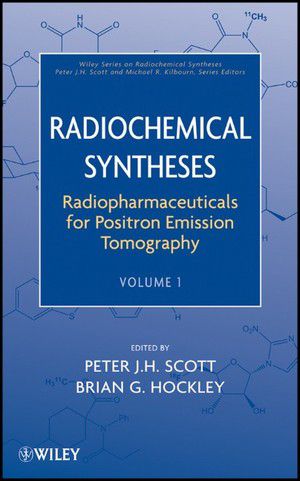Radiochemical Syntheses Vol 2

Introduction
This book describes methods and procedures for preparing PET radiopharmaceuticals, and highlights new methods for conducting radiochemical reactions with carbon-11 (C11) and fluorine-18 (F18), which are two of the most commonly used radionuclides in positron emission tomography (PET) imaging.
Contents
Radiochemical sntheses Volume 2 solicits work in the following areas: (a) provides reliable methods for radiochemical syntheses and reactions, including all essential information to duplicate the procedure; (b) eliminates the time-consuming process of searching journal articles and extracting pertinent details from lengthy experimental sections or supporting information; (c) focuses on an emerging and important area for pharmaceutical and medical applications; (d) encompasses technical, regulatory, and application aspects; (e) includes solid-phase radiochemistry, transition-metal catalyzed radiochemistry, microfluidics, click chemistry, green radiochemistry and new strategies for radiopharmaceutical quality control.
Radiochemical Syntheses

Introduction
Radiochemical Syntheses is a new book series to be published by John Wiley and Sons. The purpose of Radiochemical Syntheses (Rad. Syn.) is to provide radiochemical procedures that are reliable, repeatable and provide all necessary information to carry out the synthesis in a single source. Rad. Syn. is intended to be the radiochemical counterpart to the hugely popular Organic Syntheses series.
Contents
Radiochemical Syntheses solicits work in the following three areas: (a) synthesis of PET radiopharmaceuticals (11-C, 18-F, 13-N, 15-O, 64-Cu, 68-Ga etc.); (b) synthesis of SPECT radiopharmaceuticals (99m-Tc, 67-Ga, 90-Y, 111-In, 124-I, 131-I etc.); and (c) labeling with long-lived radionuclides (14-C, 3-H, 32-P, 35-S etc.).
Solid-Phase Organic Syntheses

Introduction
A unique book series dedicated to providing organic chemists with the latest solid-phase synthesis procedures. John Wiley & Sons, Inc. is pleased to announce plans to publish Solid-Phase Organic Syntheses (SPOS), a new book series that will provide organic chemists with verified solid-phase synthesis procedures that can be repeated in the laboratory. Though focusing on library synthesis procedures, other issues addressed may include resin preparation, library screening and encoding. The series is an homage to the famous Organic Syntheses series created at the University of Illinois in the 1940’s. Volume 1 was edited by Anthony Czarnik and published in 2001. In 2009, Peter Scott took over as the Editor in Chief and is pleased to announce that SPOS Volume 2: Solid-Phase Palladium Chemistry is currently in preparation.
Contents
SPOS is presently soliciting submissions in the following areas: (a) synthetic routes leading to libraries with at least two diversity-introducing stems; (b) linker strategies (cleavage); and (c) methods for the preparation of broadly-useful synthesis resins. Solid-phase quench methodologies for library generation, while of obvious value, are not considered appropriate for this series; however, the preparation of the resins themselves may be.
Editorial Office Contact Details
Peter Scott, Ph.D. and Michael R. Kilbourn, Ph.D.
Division of Nuclear Medicine
Department of Radiology
University of Michigan Medical School
1301 Catherine Street
2276 Medical Science I Building
Ann Arbor, MI 48109, USA
Tel: (PJHS) (734) 615-1756
Tel: (MRK) (734) 763-9246
Fax: (734) 615-2557
[email protected]
